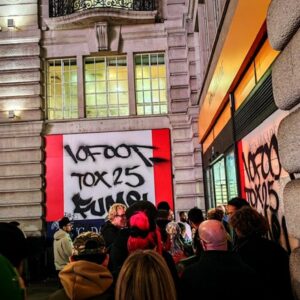Andreas Stylianou’s recent solo exhibition, HOLOMORPHOSIS, is a stimulating extrapolation of historical narratives created in response to the treasured permanent collection at the Pierides Museum.
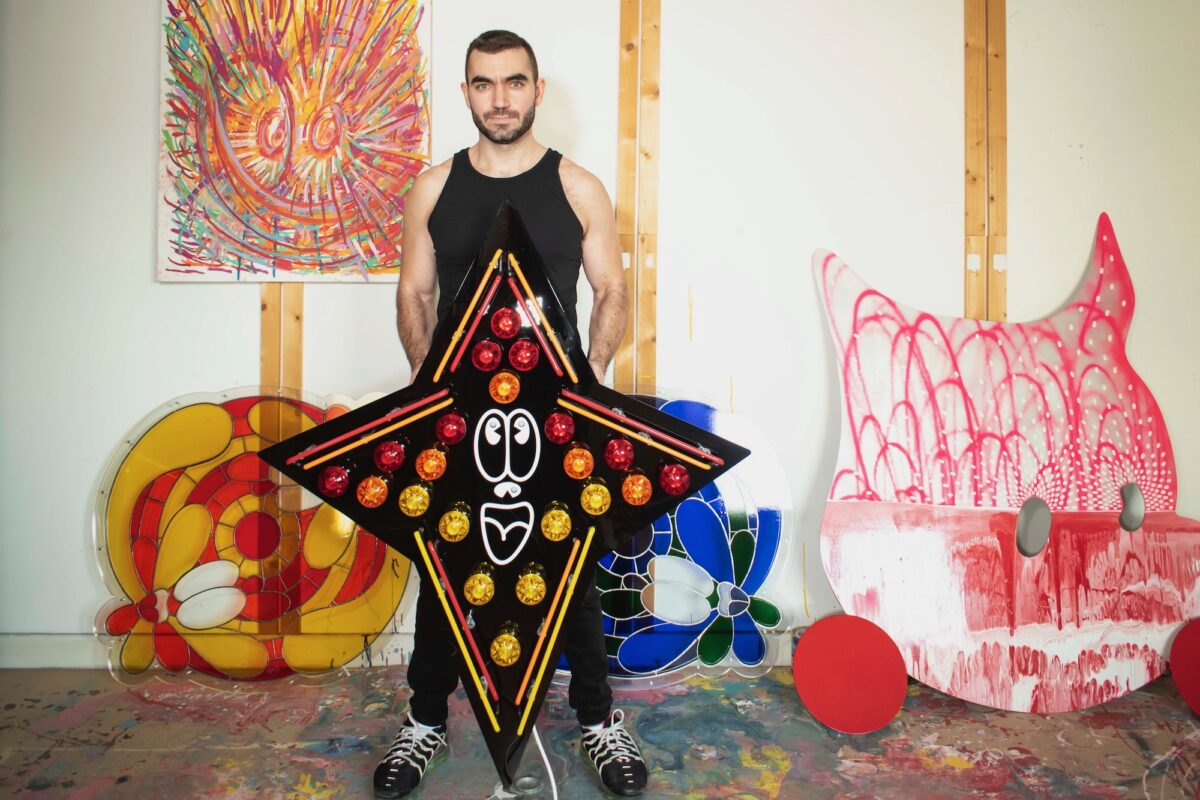
The exhibition engages the visitor with the ancestral and the new by melding contemporary artistic visions with historical objects. Taking place over seven spaces within the museum, the presentation features works in impressively diverse mediums, encompassing energetic paintings, luminous neon installations, colourful ceramics, bronze and stainless-steel sculptures and stained glass tessellation. In partnership with Future DMND in Los Angeles and curated by Katerina Patsalidou, the exhibition runs through to 29th February 2024 in Larnaca, Cyprus.
Jessica Wan visited Andreas in his studio in central Nicosia to hear about the making behind this latest body of work.
Jessica Wan: It’s my first in the studio. How exciting! Could you start by sharing your artistic journey and what inspires you?
Andreas Stylianou: I always wanted to be an artist but initially pursued architecture, out of fascination and respect to the profession. However, after completing my studies, there was no space for my vision within the traditional architecture world in its current state. One summer, I impulsively set up my studio with minimal resources, creating my first series of paintings. Surprisingly, galleries showed interest, making me realise being an artist was a viable path. This experience revealed the possibilities I never thought existed.
My primary inspirations are Ugo Rondinone and Wolfgang Tillmans. Despite their differences, they document life to essence, Rondinone through materials and Tillmans through photography. While I may not have a connection to photography, the shared preoccupation of documenting human conditions resonates with all artists. I admire Tillmans for capturing living experiences through his lens and Rondinone for transforming surroundings and nature into personal expressions.
JW: Your recent exhibition at the Pierides Museum is the result of in-depth research into historic objects from the Early Bronze Age, Roman glassware, and medieval ceramic dishes to ancient Greek and Cypriot sculptures in the collection. What does the exhibition title mean? What do you do to generate new ideas when exploring the past?
AS: One of the reasons I chose the title for the show is because it was a new term for me, representing my quest to find the right word for my artistic direction. “HOLOMORPHOSIS” allowed me to define it partially in my own terms, unlike other words that came with predetermined meanings. It conjures an image of a beautiful pink lizard with a cut-off tail that grows and completes itself—a personal definition. Beyond its dictionary definition of the complete regeneration of a lost part, I saw it as an opportunity to explore and meet the dormant cultural heritage of Cyprus.
My show aimed to create my version of a complete story, breathing new life into the museum’s collection. While the existing works are preserved for observation and education, my intervention aimed to infuse the collection with a dynamic and evolving narrative, bringing a level of excitement and engagement that visitors could experience.
Regarding ideas, my mind tends to race, and I rethink and overthink everything constantly. Rather than obliterating what came before, I aim to evolve ideas comprehensively. As an architect, my approach involves building upon existing concepts. An example is remaking the neon installations for this exhibition by incorporating new elements like funfair lights into the design. What is the greatest way I can manipulate something for the optimal visual effect?
A crucial aspect of my process is translating instructions into tangible works we live with. Everything begins with plans and drawings, be it 3D sculptures or neon installations. I collaborate closely with artisans, drawing on their expertise to bring my vision to life.
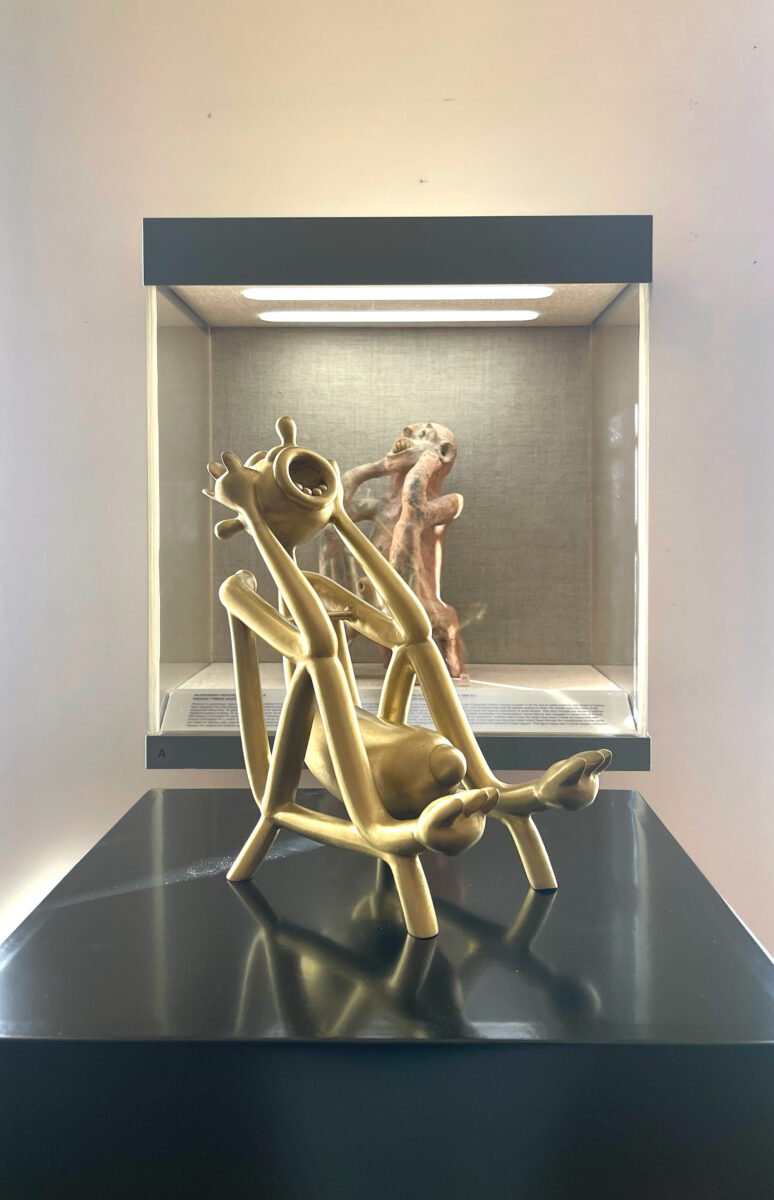
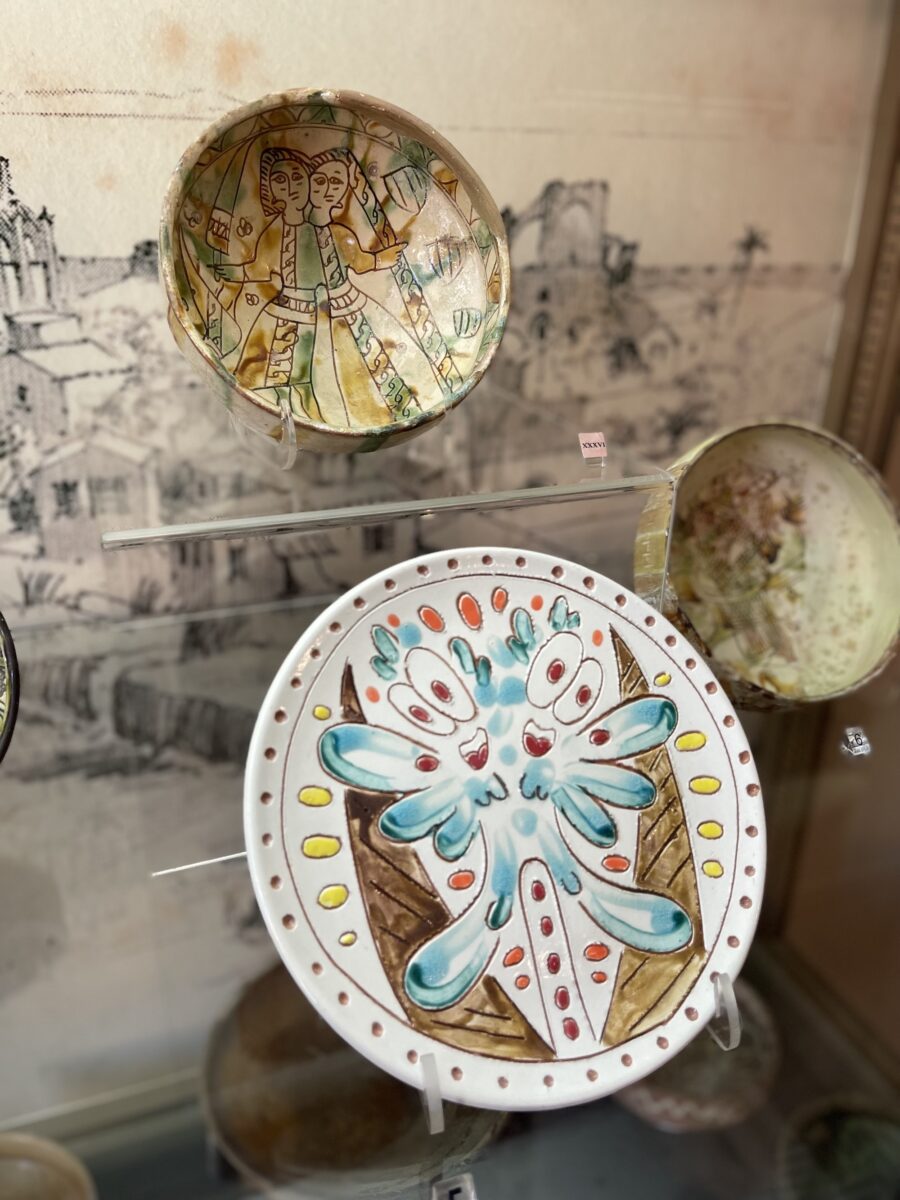
JW: Could you talk a bit more about the Infinity Clock on view?
AS: As you enter the exhibition, the first work you will see is the Infinity Clock, which is an installation of 12 plates. The engraved symbols are usually used to communicate ideas. I created this clock that references the past and has been made in the present but will continue to live in the future. The objects on display in the room where the Infinity Clock is placed are mostly medieval plates made with brown clay, painted with white clay, and then etched at the right time. And the right time was something that was indicated to me by the artisans who have mastered these reproduction techniques in Cyprus. And for me, it was very important to honour these traditions and heritage. For artisans, these are treasured through the generations. There is a disconnect in this lineage because not enough young people in Cyprus are willing or want to continue this craft. The future could be more promising in the safekeeping of these techniques. It’s incredible that I could work on an exhibition like Holomorphosis, which involves preserving this craft process and passing on cultures.
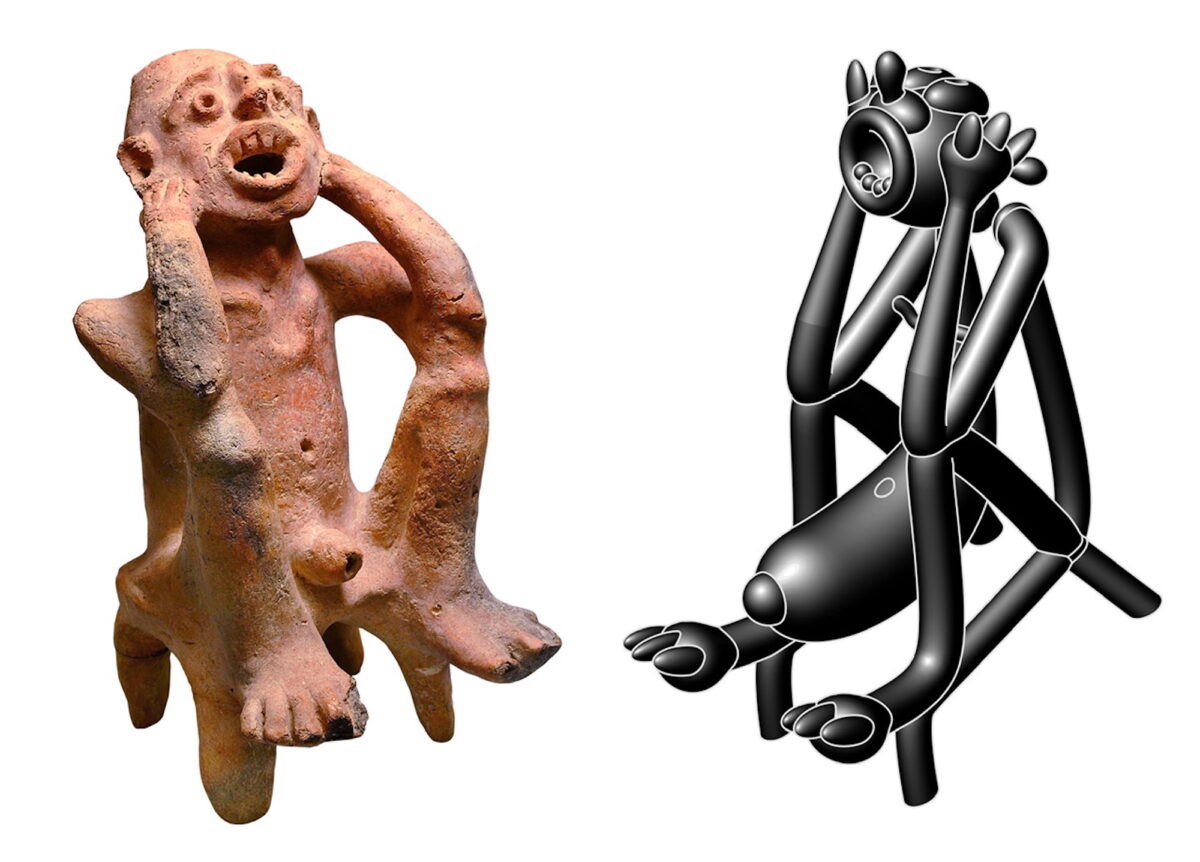
JW: How do you make these material decisions? What are the thinking processes?
AS: The creation of The Seated Male Figure (2022-2023), crafted from bronze, was inspired by a terracotta sculpture dating back to 3900 BC. This mysterious figure, who seemed to be experiencing a psychological transformation from the museum collection, immediately captivated me. I started 3D modelling it on my computer and had to decide how this would be translated. I wanted to create a centrepiece for the museum, so bronze would be the most fitting choice.
The process of transforming the sculpture into bronze presented a series of challenges, including the patina options and the final appearance of the piece. I initially considered hues like pink and black due to their resemblance to terracotta. Ultimately, I chose to use the pure form of bronze, foreseeing its ability to evolve in appearance over the next century. This choice aligns with the essence of the show, “Holomorphosis”, symbolising the completion of what preceded it.
Returning to The Seated Male Figure, I view it as a distinctive highlight of the exhibition. Integrating modern techniques with ancient materials resonates with me, evoking a sense of time travel. The original figure, created in the Neolithic period, holds an ancient mystery, resembling a psychological scream rather than a decorative or expressive piece. The juxtaposition of the original’s antiquity and the futuristic recreation using 3D printing creates a captivating contrast, allowing the audience to stand at the intersection of the past and future.
While conceptualising this exhibition, I found myself making in the present while acknowledging that these works, once artefacts of the present, will live in the future. It’s a negotiation between the present’s lived experience, the mystery of the past, and the anticipation of an equally mysterious future. This interplay became a profound source of inspiration, fueling my energy to create the diverse works featured in the show.
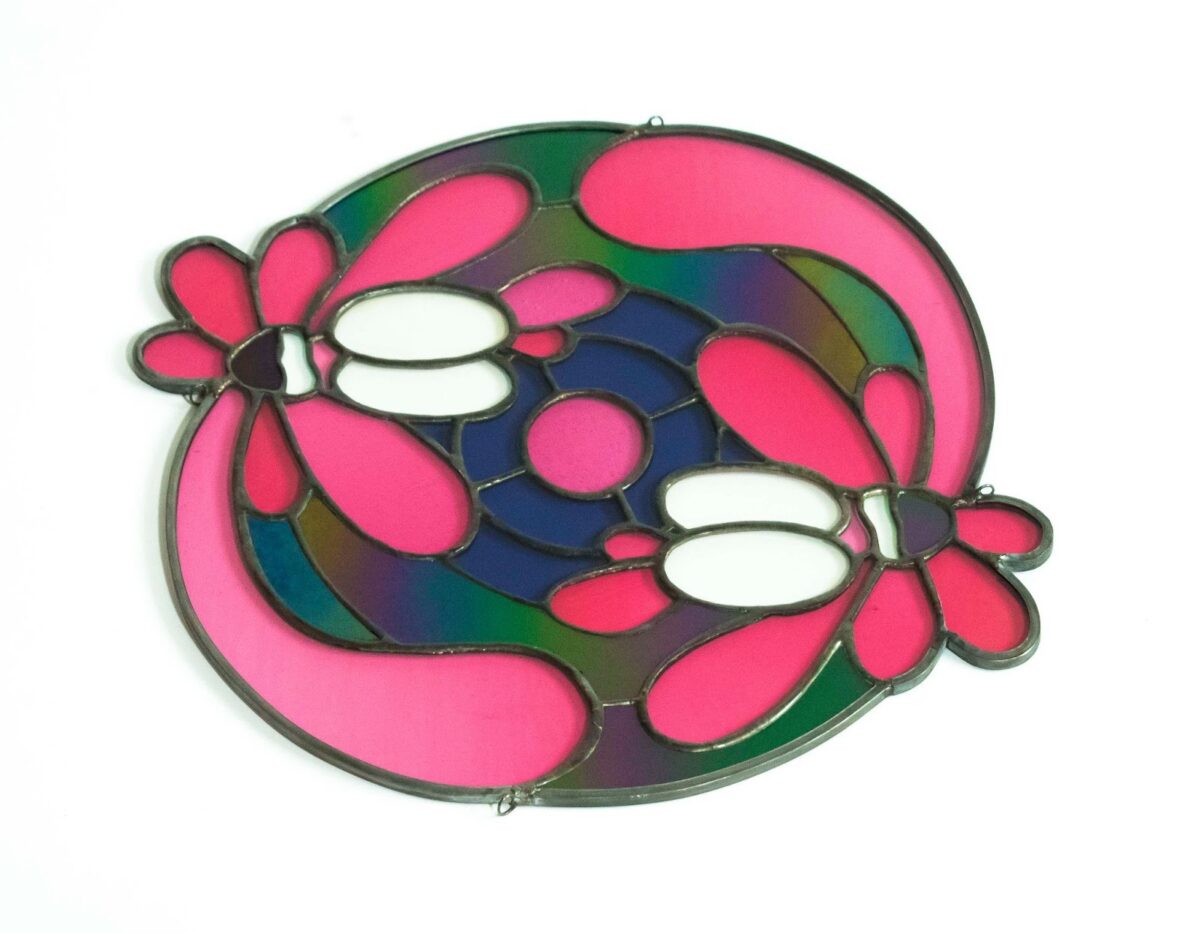
JW: The creative exchange between you and the crafts community is unique here. Could you elaborate on your working processes with local artisans and how you integrated their perspectives into your artistic approach while thinking through the historical narratives in the museum collection?
AS: In approaching this project, I tapped into the expertise of various specialists, recognising each person’s unique skills. The first was Michael at “Emira Pottery” in Larnaca, who prepared the brown clay bases for the works. Next, I worked with Efthymios, at “Studio Ceramics Cyprus”, who painted the brown clay with white clay—an exclusive technique in replicating the medieval craft. He provided precise instructions for carving the clay. I then brought the plates back to my studio, carved them using the craftsmen’s instructions, and moved on to another pottery studio, “Xoma ke Nero”, for glazing and firing. The work involved three different workshops, each contributing to Cyprus’s pottery tradition, which adds a unique dimension to the project.
The Rainbow Targets, is a series of works made with stained and fused glass techniques. Inspired by a room in the museum dedicated to Roman glass, I wanted to capture the radiance that evolves over time due to glass oxidisation. Collaborating with a specialist in Cyprus who excels in glasswork, we used chemically altered glass to achieve the desired iridescence. This intervention, sometimes literal, other times borrowing intriguing elements, resulted in self-indulgent compositions of characters.
It’s been my greatest pleasure to work with Roswitha, a glass specialist in Limassol, whose lifelong dedication to the craft was crucial to the reproduction process. Her commitment allowed me to work closely to ensure the compositions aligned precisely with my vision, with not a single angle deviating from what I intended.
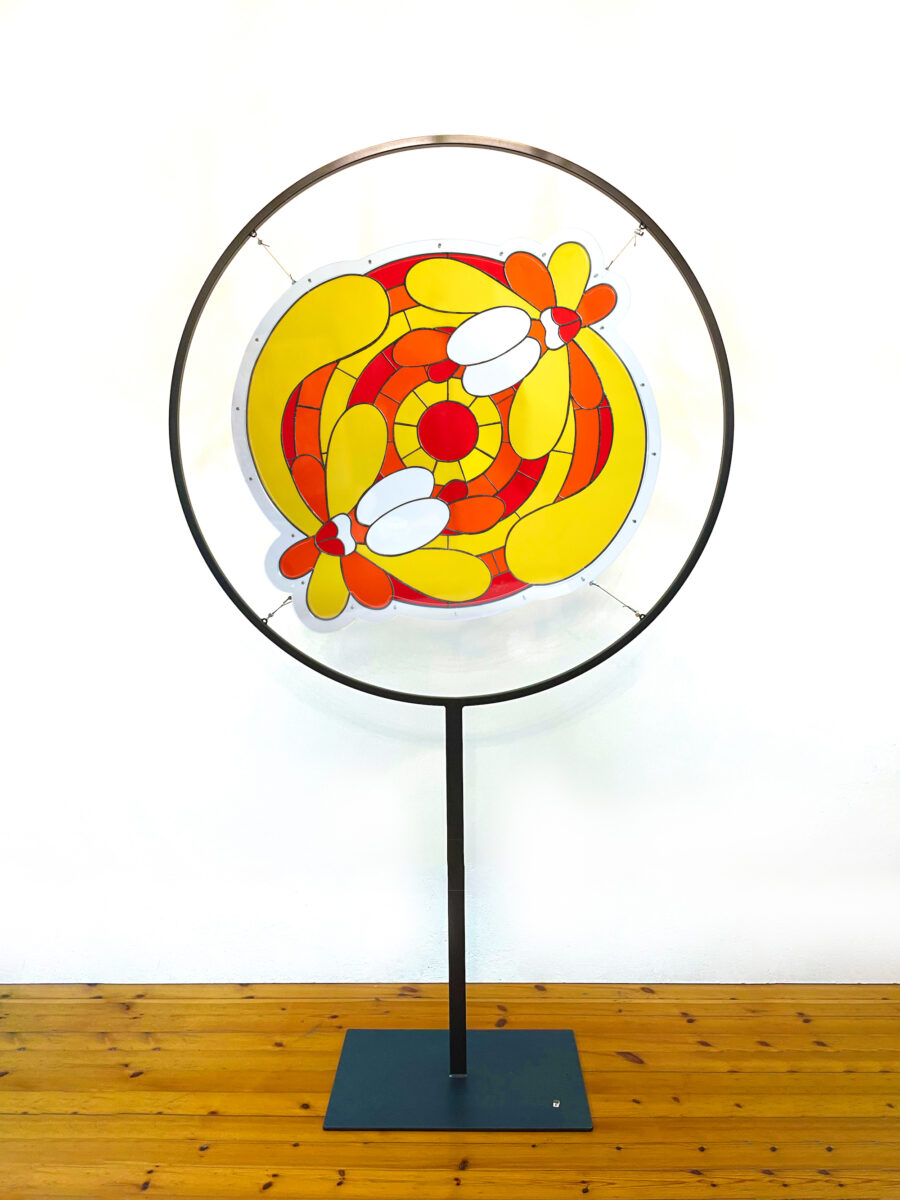
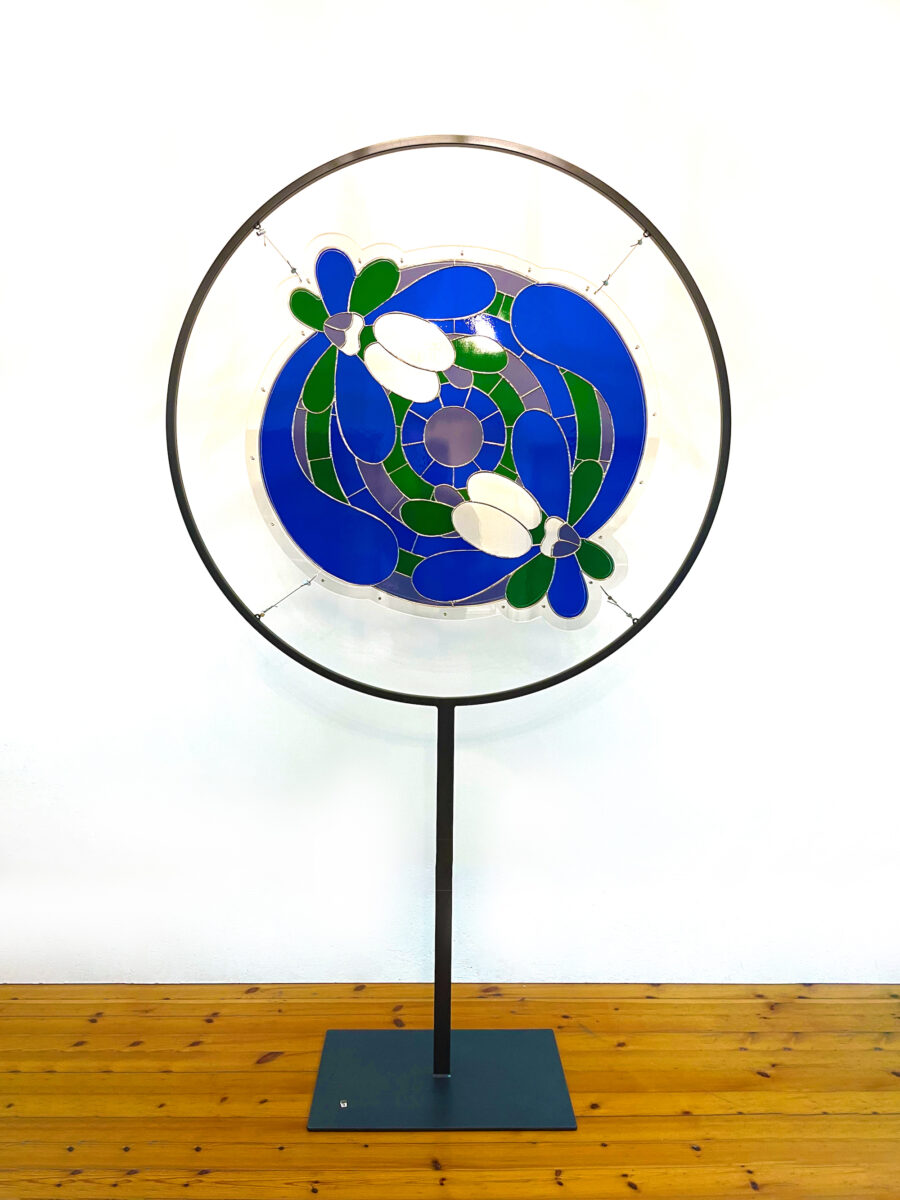
JW: What are the emergent issues with cultural preservation here in Cyprus?
AS: A primary issue is the lack of arts education and funding in Cyprus which hinders young artists due to an absence of sustainable revenue streams. There’s also a noticeable gap in understanding artistic lineage. Cultural heritage museums often separate antiquities from contemporary art, creating a divide between traditional techniques and the art of today.
It’s a miss that artefacts and artworks aren’t considered closely related. For example, the seated male figure is as much an artwork as anything else. Bridging this gap is crucial because passive engagement with cultural objects in heritage museums impedes a meaningful connection, suggesting a static view of history. A dialogue between contemporary art and the historic collection offers a unique perspective on heritage, making the past more accessible.
Personally, my engagement with museum works deepened my respect for the past, leading to transformative personal works. The goal isn’t about my works receiving credit but enriching my understanding of life’s progression, fostering an enhanced appreciation of our cultural narratives.

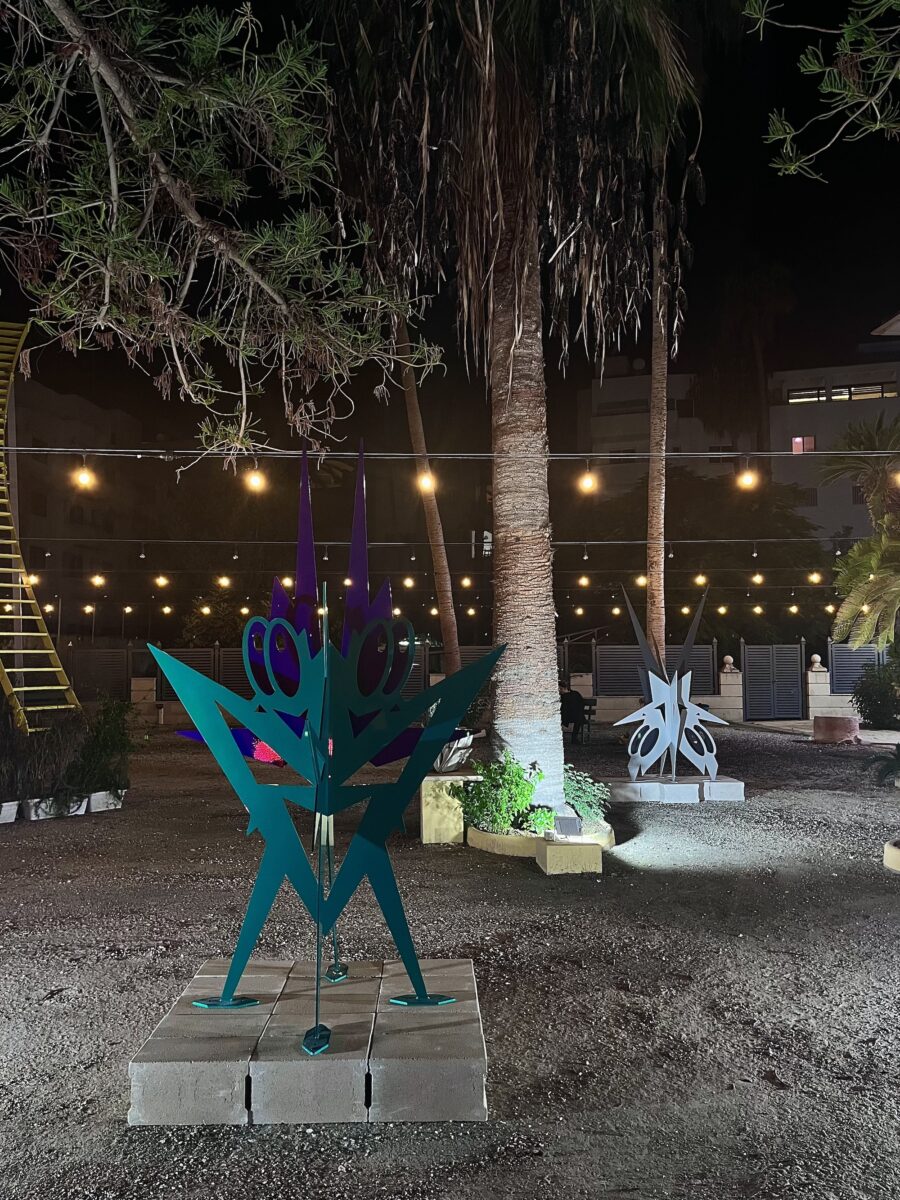
JW: Let’s move on to talk about the Optimus Prime Installation, which consists of nine illuminating neon light boxes characterised by stylistic lines, centring your signature character, the ‘Alter ego’. There are also the aluminium Starscream public sculptures in the courtyard and hallway of the museum.
AS: The inspiration for this piece stemmed from the intricate star-patterned embroideries adorning the walls of the staircase in the family gallery’s house. These delicate creations, made from the thinnest materials, have prompted me to explore how their essence could be transformed into a vibrant, exuberant presence – a departure from the inherent lightness of the fabric. The result was compositions crafted using funfair lights and neon lights, a departure from my usual focus on curves, as I delved into working with angles to create these dynamic works. Despite the rhombus shapes’ initial awkwardness, an elegance emerges, mirroring the refined embroidery in the museum.
In Cyprus, where this Historic house is located, listed buildings entail stricter preservation guidelines than those in London. The permanence of the house’s listed status and unalterable features, including the tiled floors, inspired my aluminium sculptures. Designed to withstand outdoor conditions, they echo the enduring nature of art itself. The Starscream sculptures, featuring two distinct star patterns, represent a duality – one star grounded like a fallen comet, painted with powder-coated aluminium, and the other ethereal, suspended in the sky, coated with automotive paint on aluminium. This deliberate choice in painting techniques reflects the weight and lightness of elements, bridging the gap between the grounded floor and the weightless sky.
The interplay between these three-dimensional, flat-surface sculptures creates an intriguing dynamic. It’s akin to bringing elements from the past into the present and reimagining them for the future – a metaphor for revealing and reinterpreting history. Working with this significant collection has been a unique opportunity. I hope to continue exploring similar avenues in the future, actively engaging with the past and transforming the old into the new.
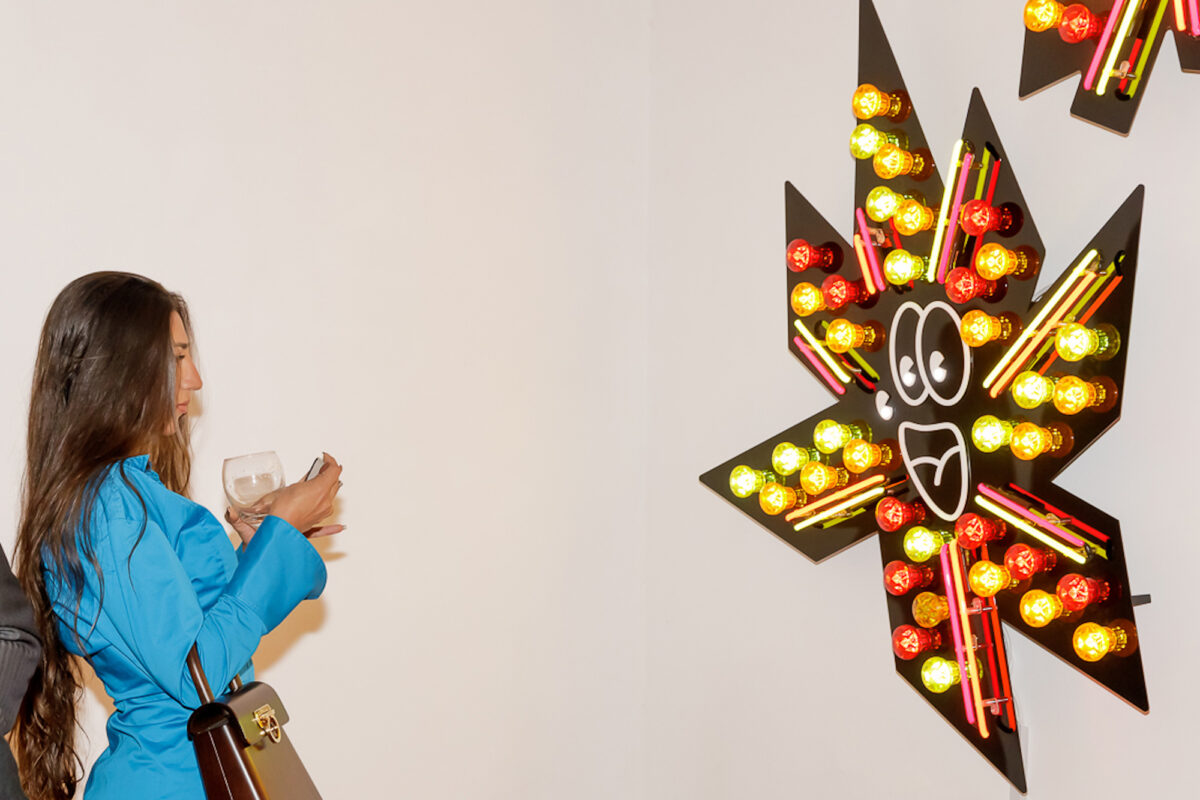
JW: Having worked with such a celebrated archaeological collection and in a unique historic building, how would these experiences inform your future practices?
AS: It’s been two years since I started working on this exhibition. By actively choosing to collaborate with independent makers, I learnt that we are not only preserving the craft but also revitalising techniques and aesthetics, challenging how craft methods can contribute to contemporary works that remain relevant today.
Engaging with artisans is an acknowledgement of their artistic prowess. While it wasn’t easy to collaborate, establishing a working relationship was rewarding. Despite the initial challenges, I foresee a positive evolution for myself. Through the processes of creating these works, there’s a tangible sense that something essential is kept alive, contributing to the ongoing vitality of the craft.
Reflecting on this journey, I also want to express my gratitude to those who supported the exhibition. I couldn’t have done it alone. Special thanks to Future DMND and its director Issa Ababseh, the show’s steadfast supporter, and to Dr. Demetris Pierides and Peter Ashgian, founders of the museum, for encouraging me to explore the collection without restrictions. Also, to my contributors, who dedicated the resources and motivation to materialise my ideas. The development of this exhibition has been a collaborative effort with those who believe in the vision at every step.
About the Artist
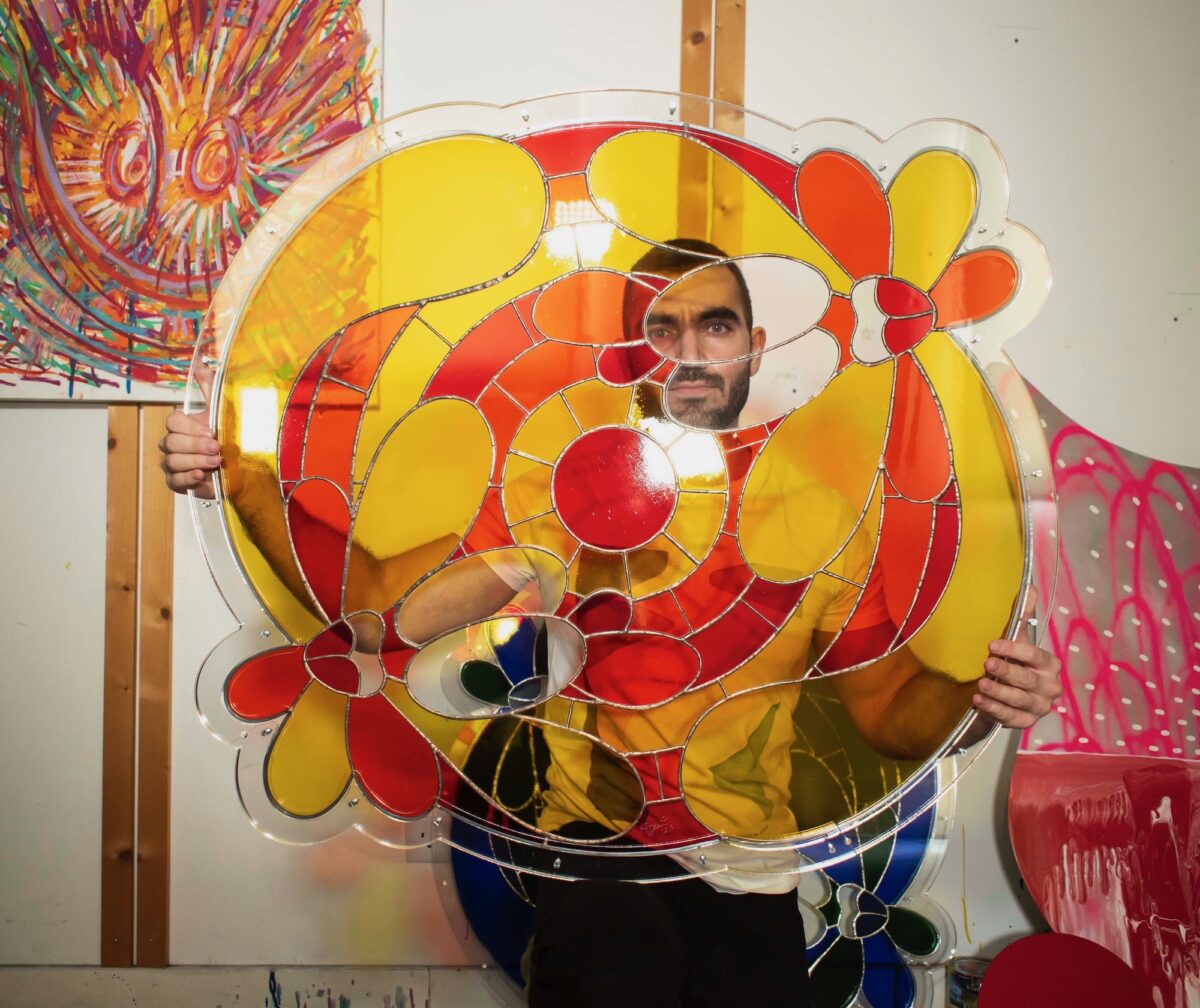
Andreas Stylianou (Cypriot, b.1990) is a multidisciplinary artist based in Cyprus. After studying at the Architectural Association in London, he attained an MA at the Royal College of Art. Stylianou’s practice explores materiality to give life to a previously dormant world. Drawing upon his architectural background, Stylianou captures the essence of self in relation to time using intuitive mark-making and meditative painting techniques. His work evolves through biographical narratives intersecting contemporary pop characters, vibrant colours, and processes. Stylianou has exhibited internationally in the US, UK, Germany, Italy, Hong Kong, and Cyprus. @and.sty7



